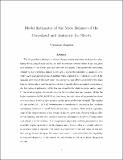| dc.contributor | Bugnion, Véronique. | en_US |
| dc.date.accessioned | 2003-10-24T14:56:36Z | |
| dc.date.available | 2003-10-24T14:56:36Z | |
| dc.date.issued | 1999-10 | en_US |
| dc.identifier.other | no. 54 | en_US |
| dc.identifier.uri | http://mit.edu/globalchange/www/abstracts.html#a54 | en_US |
| dc.identifier.uri | http://hdl.handle.net/1721.1/3592 | |
| dc.description | Includes bibliographical references (p. 31-34). | en_US |
| dc.description | Abstract in HTML and technical report in HTML and PDF available on the Massachusetts Institute of Technology Joint Program on the Science and Policy of Global Change website (http://mit.edu/globalchange/www/) | en_US |
| dc.description.abstract | The six possible combinations of two climate models and three methods for calculating the melting of snow and ice are used to estimate current values of accumulation and ablation on the Greenland and Antarctic ice sheets. This allows the contrasting of high vs. low resolution climate input and to assess the reliability of simple temperature based parameterizations of melting when compared to a physical model of the seasonal evolution of the snow cover. In contrast to past efforts at modelling the mass balance of Greenland and Antarctica, the latter model allows an explicit calculation of the formation of meltwater, of the fraction of meltwater which refreezes and of runoff in the ablation region, this is not the case for the other two melt models. While the higher resolution GCM (ECHAM 4) does bring the estimation of accumulation closer to observations, it fails to give accurate results in its predictions of runoff. The simpler climate model (MIT 2D LO) overestimates accumulation in Antarctica but produces satisfactory estimates of runoff from the Greenland ice sheet. Both models reproduce some of the characteristics of the extent of the wet snow zone observed with satellite remote sensing, but the MIT model is closer to observations in terms of areal extent and intensity of the melting. The temperature dependent melting parameterizations generally require an accuracy in the climatic input beyond what is currently achieved to produce reliable. Because it is based on physical principles and relies on the surface energy balance as input, the snow cover model is believed to have the capability to respond adequately to the current climatic forcing as well as to future changes in climate. | en_US |
| dc.description.sponsorship | Supported by the Alliance for Global Sustainability, the MIT Joint Program on the Science and Policy of Global Change and NASA as part of the NASA GISS Interdisciplinary EOS Investigation NAG5-7204 | en_US |
| dc.format.extent | 34 p. | en_US |
| dc.format.extent | 1039608 bytes | |
| dc.format.mimetype | application/pdf | |
| dc.language.iso | eng | en_US |
| dc.publisher | MIT Joint Program on the Science and Policy of Global Change | en_US |
| dc.relation.ispartofseries | Report no. 54 | en_US |
| dc.subject.lcc | QC981.8.C5 M58 no.54 | en_US |
| dc.title | Model estimates of the mass balance of the Greenland and Antartic ice sheets | en_US |
